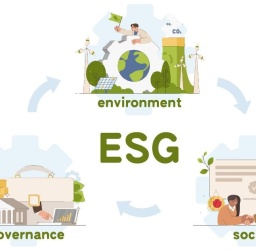Environmental, Social, and Governance (ESG) Internal Audit

What is ESG?
Environmental, Social and Governance (ESG) refers to a set of standards for a company’s operations that socially conscious investors use to screen potential investments. Environmental criteria consider how a company safeguards the environment, including corporate policies addressing climate change, waste, pollution, natural resource conservation and animal treatment. The social dimension examines how it manages relationships with employees, suppliers, customers and the communities where it operates. Meanwhile, governance deals with a company’s leadership, executive pay, audits, internal controls and shareholder rights.
The importance of ESG has risen as stakeholders have become increasingly aware of the potential impacts of business operations on the environment and society. Companies are under growing scrutiny not just for their profitability but also for their environmental stewardship and social responsibility. This shift is driven by the recognition that sustainable practices often lead to financial outperformance in the long run. Investors, consumers and regulatory bodies are demanding greater transparency and accountability, leading to ESG factors becoming increasingly critical elements in investment decision-making and corporate strategies.
Internal and External Auditing
This growing scrutiny has led to the auditing of ESG elements both internally and externally. This has become essential in the process of ensuring accountability and transparency in an organisation’s operations. Internal audits help companies identify areas of improvement within their ESG frameworks, ensuring that their practices align with stated policies and objectives. External audits, conducted by independent parties, provide an added layer of credibility and reassurance for stakeholders, including investors, regulators and the public, confirming that the company’s ESG reporting is accurate and reliable. Together, these audits enhance stakeholder trust, meet regulatory requirements, and support the integration of sustainable practices into core business strategies.
The internal audit of ESG elements is undoubtedly crucial, and possibly even more necessary and important than an external audit. It allows organisations to proactively manage risks and opportunities from within, ensuring that ESG practices are deeply integrated into all business operations and aligned with strategic objectives. This continual internal review helps companies stay ahead of regulatory changes, adapt to evolving stakeholder expectations, and maintain operational integrity, ultimately driving sustainable growth and long-term value creation. So, having established the importance of an internal audit, it is necessary to consider how that audit should take place, what essential elements it should consider, and also who should conduct the process for maximum effect.
EXPLORE ALL TRAINING OPPORTUNITIES BY EIMF
Conducting an Internal ESG Audit: Methodology and Best Practices
An internal audit of ESG criteria is essential for companies committed to sustainable and ethical operations. This audit evaluates the alignment of the company’s practices with ESG standards and identifies areas for improvement. The process not only helps in risk management and enhancing brand reputation but also aligns with investor expectations and regulatory requirements.
Initiating the Audit
The process begins with the formation of an audit team. This team should ideally include individuals from diverse company functions such as compliance, human resources, operations and finance. Including a member of the board or a high-level executive can also provide an authoritative perspective and facilitate the implementation of recommendations. For more specialised aspects of ESG, such as environmental regulations, it might be beneficial to hire external consultants who bring specific expertise and an objective viewpoint.
Defining the Scope and Objectives
The scope of the audit should be clearly defined at the outset. This includes deciding which ESG factors to evaluate, such as waste management, labour practices or corporate governance structures, for example. The objectives might include compliance with specific regulations, alignment with global ESG standards like the Global Reporting Initiative (GRI) or the Sustainability Accounting Standards Board (SASB) or achieving specific internal sustainability goals.
Data Collection and Analysis
Once the scope is defined, the next step is extensive data collection. This involves gathering quantitative data like energy consumption metrics or employee demographic statistics, and qualitative data such as policies on diversity or community engagement activities. Interviews with key personnel and surveys among employees can provide insights into the efficacy and perception of current practices.
The collected data should be analysed to assess compliance with the established ESG criteria and to benchmark performance against industry standards or previous internal metrics. Advanced analytical tools and software can assist in handling large datasets and drawing meaningful insights.
EXPLORE ALL TRAINING OPPORTUNITIES BY EIMF
Addressing Key Questions
The audit should aim to answer several key questions:
How effectively are the current ESG policies being implemented?
Where does the company stand in terms of industry standards?
What are the risks of non-compliance or poor performance in ESG areas?
What opportunities exist for enhancing ESG performance?
These questions help in identifying not just gaps but also areas where the company is performing well or could leverage for greater impact.
Recording and Presenting Findings
The findings of the audit should be meticulously documented in an audit report. This report should include detailed descriptions of the methodologies used, the data collected and the conclusions drawn. It should clearly outline both strengths and weaknesses in the current ESG practices and recommend actionable steps for improvement. The presentation of the findings is equally important. It should be conducted in a manner that is accessible to all stakeholders, including senior management and the board of directors. Utilising visual aids like charts, graphs and tables can help in illustrating points more effectively and in making the case for proposed changes.
Review and Follow-up
Finally, the audit should not be seen as a one-time activity but as part of an ongoing commitment to ESG excellence. Setting up a periodic review and follow-up on the recommendations is crucial. These follow-ups ensure that the actions are implemented and help in maintaining a dynamic approach to ESG challenges and opportunities as the business and external conditions evolve.
As part of this consideration of internal auditing, it is valuable to also consider some common mistakes that are made in the process:
EXPLORE ALL TRAINING OPPORTUNITIES BY EIMF
Common Mistakes in Conducting Internal ESG Audits
1. Inadequate Scope Definition: Often, audits falter by not clearly defining what ESG areas to evaluate.
Potential Solution: Establish a precise scope aligned with strategic objectives and compliance needs before initiating the audit.
2. Insufficient Stakeholder Involvement: Failing to involve a diverse range of stakeholders can lead to missed insights.
Potential Solution: Engage various groups, including employees, management and external experts, throughout the auditing process to ensure comprehensive perspectives.
3. Overlooking Post-Audit Actions: Many audits lack impact due to poor follow-through on recommendations.
Potential Solution: Develop a structured plan with timelines for implementing audit recommendations and ensure regular reviews to track progress.
A Strong ESG Performance
Conducting an internal ESG audit is more than a regulatory formality; it is a strategic imperative for future-proofing a business. As detailed in this article, effective internal audits help companies proactively enhance their operational integrity, adapt to evolving market expectations, and harness sustainable practices for long-term success. By aligning ESG standards with business strategies, companies not only meet investor and regulatory expectations but also gain a competitive edge. It is crucial that firms avoid common pitfalls such as inadequate scope definition and insufficient stakeholder involvement, ensuring that ESG principles are deeply embedded and consistently applied. Ultimately, a well-conducted internal audit fosters transparency, accountability and continuous improvement, leading to robust ESG performance and sustainable value creation.
Related Training Programmes
06/06/2024 - Factoring Financing
13/06/2024 - MiFID II, Sustainable Finance, and ESG Integration: Navigating the Regulatory Landscape
17/06/2024 - The EU Regulatory Disclosure Framework for Managing ESG Risks by Financial Institutions
18/06/2024 - International Accounting Standards (IFRS/IAS) – The Latest Developments
18/06/2024 - Environmental, Social, and Governance (ESG) Internal Audit
26/06/2024 - Overview of the Directive on Administrative Cooperation (DAC8): Marking the end to crypto-asset non-taxation
26/06/2024 - Company Taxation and the Administrative and Procedural aspects of the Cyprus Tax System
Share:
Διαβάστε Επίσης
Πρόκειται για εκθέσεις που καταγράφουν με διαφάνεια τις επιδόσεις μιας εταιρείας
Στόχος είναι η συνολική ικανότητα παραγωγής στρατηγικών τεχνολογιών μηδενικών καθαρών εκπομπών
 Ελληνικά
Ελληνικά  English
English


